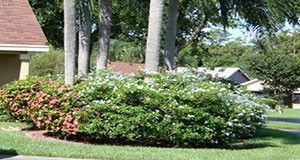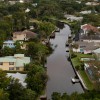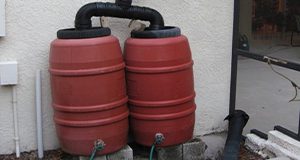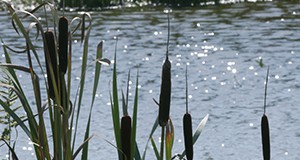Rain barrels make it easy for households to practice water conservation. Extension programs for rain barrel construction, decoration, and giveaways can raise awareness for (and encourage use of) this technology. This 9-page document will provide insight into the behavior and attitudes of rain barrel owners so that Extension professionals may gain a better understanding of this unique audience. Written by Emily Ott, Paul Monaghan, Wendy Wilber, Lynn Barber, and Karissa Raymond and published by the UF/IFAS Department of Agricultural Education and Communication, March 2018.
http://edis.ifas.ufl.edu/wc297
Tag: Emily Ott
Strategies to Encourage Adoption of Stormwater Pond Best Management Practices (BMPs) by Homeowners
Man-made ponds can be a useful way to collect, store, and treat stormwater runoff in residential areas. However, these ponds can become polluted when runoff contains fertilizers, pesticides, and pet waste from the neighborhood. This 8-page fact sheet outlines several best management practices (BMPs) for reducing stormwater pond pollution. Based on a survey of residents who live near stormwater ponds, the authors recommend strategies Extension educators can use to encourage residents to adopt these BMPs. Written by Emily Ott, Paul Monaghan, Ondine Wells, Gail Hansen, Laura Warner, and Michelle Atkinson, and published by the UF Department of Agricultural Education and Communication, July 2015.
http://edis.ifas.ufl.edu/wc214
Perceptions of Florida-Friendly Landscapes: Linking Visual Quality and Environmental Health through Landscape Codes

Early efforts to promote Florida-Friendly landscapes emphasized the use of drought-tolerant plants, which created a negative association with a visually unappealing landscape. This has hampered the promotion of FFL yards and the adoption by homeowner associations. But recently many homeowners are rethinking their landscape maintenance and plant choices and HOAs are considering promoting environmentally friendly landscapes but express uncertainty about recommending FFL because of the need to maintain visual quality. We conducted a study to address both groups’ concerns and help develop FFL-oriented landscape codes that meet both groups’ needs. This 7-page fact sheet was written by Gail Hansen, Laura Warner, Paul Monaghan, Emily Ott, Tim Fogarty, Claire Lewis, and Esen Momol, and published by the UF Department of Environmental Horticulture, April 2015.
http://edis.ifas.ufl.edu/ep519
The Florida Natural Resources Leadership Institute
 We are all dependent on Florida’s natural resources for jobs, health, and our quality of life. Decisions about the management and conservation of the State’s environment involve complex sets of issues and stakeholders. Expensive and time-consuming disputes often emerge over topics such as endangered species, land use, coastal and marine resources, and water quality and quantity. Effective leadership in managing such issues requires a specialized set of skills, tools, and strategies to build trust and promote innovation and collaboration among competing interests. To meet these needs, the Florida Natural Resources Leadership Institute (NRLI) was founded in 1998 to bring together professionals and stakeholders from diverse natural resource sectors to develop the skills required to engage the public and one another in collaborative decision-making. This 4-page fact sheet was written by Paul Monaghan, Emily Ott, Carol Lippincott, Ondine Wells, Jessica Ireland, Jon Dain, Bruce Delaney, and Roy Carriker, and published by the UF Department of Food and Resource Economics, December 2014.
We are all dependent on Florida’s natural resources for jobs, health, and our quality of life. Decisions about the management and conservation of the State’s environment involve complex sets of issues and stakeholders. Expensive and time-consuming disputes often emerge over topics such as endangered species, land use, coastal and marine resources, and water quality and quantity. Effective leadership in managing such issues requires a specialized set of skills, tools, and strategies to build trust and promote innovation and collaboration among competing interests. To meet these needs, the Florida Natural Resources Leadership Institute (NRLI) was founded in 1998 to bring together professionals and stakeholders from diverse natural resource sectors to develop the skills required to engage the public and one another in collaborative decision-making. This 4-page fact sheet was written by Paul Monaghan, Emily Ott, Carol Lippincott, Ondine Wells, Jessica Ireland, Jon Dain, Bruce Delaney, and Roy Carriker, and published by the UF Department of Food and Resource Economics, December 2014.
http://edis.ifas.ufl.edu/fe667
Extension and Community Resilience: Improving Community Disaster Preparedness Using Online Resources
 As Extension agents work to improve the quality of life in their communities, they must increase the capacity to respond to disasters, especially in high risk areas (which includes most of coastal Florida). Community Resiliency is a community’s ability to quickly recover from adversity and it can be enhanced through planning and adaptation using easily available online resources. This 4-page fact sheet describes supplemental educational materials that can be added to community resiliency training, offering background information and specific tools for disaster preparation. Written by Emily Ott, Paul Monaghan, and Timothy Fogarty, and published by the UF Department of Agricultural Education and Communication, October 2014. (UF/IFAS photo by Milt Putnam)
As Extension agents work to improve the quality of life in their communities, they must increase the capacity to respond to disasters, especially in high risk areas (which includes most of coastal Florida). Community Resiliency is a community’s ability to quickly recover from adversity and it can be enhanced through planning and adaptation using easily available online resources. This 4-page fact sheet describes supplemental educational materials that can be added to community resiliency training, offering background information and specific tools for disaster preparation. Written by Emily Ott, Paul Monaghan, and Timothy Fogarty, and published by the UF Department of Agricultural Education and Communication, October 2014. (UF/IFAS photo by Milt Putnam)
http://edis.ifas.ufl.edu/wc187
Measuring Community Resilience using Online Toolkits
 When we return to the scene of recent disasters like New Orleans, we find that some communities and neighborhoods are able to recover faster than others, while some never completely recover. Community Resilience is defined as the ability for a community to bounce back from a disaster, adapt to changes, and become more sustainable. The resilience assessment and planning tools reviewed here range from simple, ready-to-print worksheets intended for use by average citizens to comprehensive planning exercises more appropriate for city planners, emergency service providers, and elected officials. Not all of the toolkits will apply to every community. This 6-page fact sheet was written by Paul Monaghan, Emily Ott, and Timothy Fogarty, and published by the UF Department of Agricultural Education and Communication, July 2014. (UF/IFAS photo by Tyler Jones)
When we return to the scene of recent disasters like New Orleans, we find that some communities and neighborhoods are able to recover faster than others, while some never completely recover. Community Resilience is defined as the ability for a community to bounce back from a disaster, adapt to changes, and become more sustainable. The resilience assessment and planning tools reviewed here range from simple, ready-to-print worksheets intended for use by average citizens to comprehensive planning exercises more appropriate for city planners, emergency service providers, and elected officials. Not all of the toolkits will apply to every community. This 6-page fact sheet was written by Paul Monaghan, Emily Ott, and Timothy Fogarty, and published by the UF Department of Agricultural Education and Communication, July 2014. (UF/IFAS photo by Tyler Jones)
http://edis.ifas.ufl.edu/wc172

